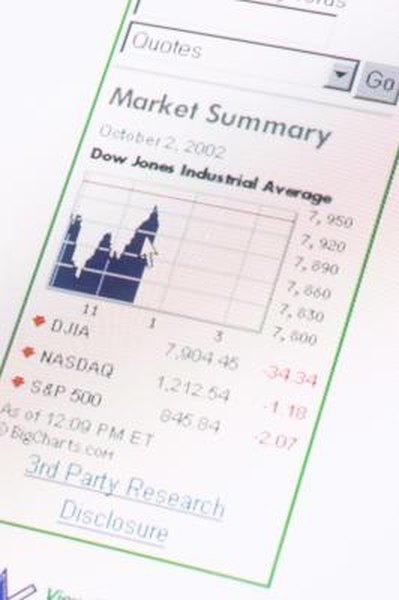Sectors of the Dow Stocks
Stock news often includes reports on the average of Dow Jones stocks.
Hemera Technologies/Photos.com/Getty Images
The Dow Jones Industrial Average contains 30 stocks. When you hear that the "Dow" moved up or down, that news summarizes what these 30 stocks did on any given day. Some of the Dow 30 may move up while others decline, so the index is an average of their performance. You may find it helpful to track the industry sectors that perform well in the DJIA, so you can anticipate which industry seems poised for new gains.
Consumer Staples
The consumer staples section indicates how consumer spending is holding up. Companies that depend directly on consumers will experience gains or losses based on the buying habits of the public. As of late 2012, companies in this sector included Altria Group, which owns Phillip Morris and 89 percent of Kraft Foods Inc. Coca Cola also belonged to this sector, as did Proctor & Gamble and Walmart. Dow membership changes because editors of the Wall Street Journal choose the companies, so listings must be checked periodically.
Industrial Materials
Companies in the industrial materials sector produce aluminum, as well as paints and coatings. At the time of publication, the companies representing the materials sector were Alcoa and DuPont. Both companies produce materials outside of their main lines of business. These materials include consumer packaging, nutritional products and safety products.
Industrials
Companies that provide industrial services along with industrial materials comprise the industrials sector. As of the end of 2012, these included Honeywell, 3M, Boeing, Caterpillar, General Electric and United Technologies. Companies in this sector own many companies you may not consider industrial, such as television networks, health care companies and financial services. The "industrial" label refers to their core businesses.
Financials
The financial sector, at the time of publication, contained American Express, American International Group, Citigroup and JP Morgan Chase. Many market observers, such as Seeking Alpha, claim that if the financial sector does not participate in a rally, the rally can't sustain itself. Chad Karnes, writing for ETG Guide, suggests that as long as both financial and energy stocks hold up, the market has room to grow.
Telecommunications
With mobile phones dominating the telecommunications sector, the two companies representing this sector were AT&T and Verizon, as of 2012. Both companies offer wireline and wireless services. "Wireline" indicates services that connect through wires or cables. These companies offer broadband access as well.
Energy
The energy sector was represented by one company at the time of publication, Exxon Mobil. In addition to oil, Exxon Mobil produces and distributes natural gas. It also owns electric power generation facilities. Market watchers treat Exxon as a "bellwether" company. That means when it does well, that's an indication that the entire energy sector may do well.
Consumer Discretionary
Companies in this sector produce or sell consumer goods that are not necessities. This sector contained General Motors, Home Depot, McDonald's and Walt Disney, as of late 2012. When the consumer discretionary sector shows strong performance, it indicates that consumers may have extra cash to spend.
Information Technology
This sector of the Dow contains computer giants that have dominated the growth of the information age. Companies at time of publication included Hewlett-Packard, IBM, Intel and Microsoft. All of these companies derive their sales from both consumers and businesses.
Health Care
The health care sector focused on three companies at the time of publication: Johnson & Johnson, Pfizer and Merck. Johnson & Johnson owns more than 250 companies that offer consumer products, pharmaceuticals and medical devices. Pfizer supplements its human pharmaceutical focus with animal health products. Merck deals in pharmaceuticals and human vaccines.
References
Writer Bio
Kevin Johnston writes for Ameriprise Financial, the Rutgers University MBA Program and Evan Carmichael. He has written about business, marketing, finance, sales and investing for publications such as "The New York Daily News," "Business Age" and "Nation's Business." He is an instructional designer with credits for companies such as ADP, Standard and Poor's and Bank of America.

